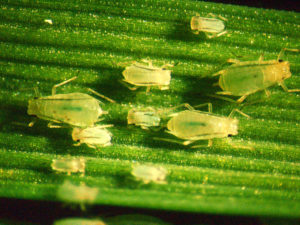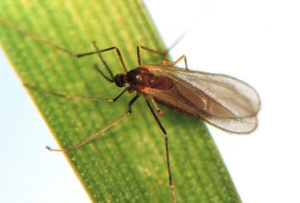Genetic discovery another tool in battle against wheat pests
Writer: Kay Ledbetter, 806-677-5608, [email protected]
Contact: Dr. Shuyu Liu, 806-677-5600, [email protected]
AMARILLO – Greenbug and Hessian fly infestations can significantly reduce wheat yield and quality in Texas and worldwide. Breeding for resistance to these two pests using marker-assisted selection just got a new tool from a Texas A&M AgriLife Research study.

Because genetics is the most economical strategy to minimize losses, AgriLife Research wheat geneticist Dr. Shuyu Liu began two years ago searching for breeder-friendly markers for those two insects. This step is a continuation of ongoing genetic work on insect resistance.
Through the years, a number of greenbug resistance genes have been identified in wheat and its relatives based on their differential reactions to different biotypes, which range from A through K. There are also 18 Hessian fly biotypes, and because it has the ability to overcome resistance genes deployed in wheat cultivars through mutations, it is necessary to identify and utilize resistance genes from diverse sources for wheat breeding.

Scientists use genetic markers to identify regions where specific genes can be found on a particular plant. Liu has identified the neighborhoods or markers for a gene offering greenbug resistance, Gb7, and a gene that provides Hessian fly resistance, H32, in wheat.
Liu’s work was recently published in the Theoretical and Applied Genetics Journal of Plant Breeding Research, detailing the development of the Kompetitive Allele Specific Polymerase Chain Reaction or KASP assays for both genes. The journal article can be found at http://bit.ly/2A0Fm9z.
Joining Liu on the publication were AgriLife Research wheat team members Drs. Jackie Rudd, Amarillo, and Amir Ibrahim, College Station, both wheat breeders; Dr. Qingwu Xue, crop stress physiologist; Dr. Chor Tee Tan, an associate research scientist; as well as other students and staff in Amarillo.
This project was funded by AgriLife Research and the Texas Wheat Producers Board.

Both genes were identified through previous research, and linked markers for them were mapped, but the detection methods were not well suited for marker-assisted selection for evaluating thousands of plants, Liu said.
He said knowing an address doesn’t mean someone knows where in the city to start looking for it. But by developing single nucleotide polymorphism, or SNPs, which include flanking markers closely linked and located on chromosomes, geneticists are able to give breeders the neighborhood to search.
SNPs are then converted into KASP assays, which are considered breeder-friendly because they are easier to use, faster and more accurate, he said.
Effective molecular markers closely linked to the target genes are the key for the success of marker-assisted selection on traits such as greenbug and Hessian fly resistance, Liu said. For instance, a breeder will typically screen 1,000s of breeding lines, and the KASP acts as a flag to say the necessary genes for a particular trait exists in a particular line.
Through Liu’s work, both genes can now be easily transferred into a new wheat line through marker-assisted selection.
Liu said the Gb7 and H32 are both found in a synthetic wheat, W7984, which is a parental line for a mapping population that wheat researchers are using worldwide. Synthetic wheats are man-made crosses between Durum or pasta-type wheats and Aegilops tauschii. These initial crosses provide access to genes of the wild relatives of wheat, thus increasing usable genetic diversity for breeders to improve winter wheat varieties.
The mapping population was developed more than 10 years ago by the International Triticum Mapping Initiative, but neither of these genes has been used for resistance in breeding programs to this point, he said.
“The reason I think they were not being used is they were in a synthetic line and it required more effort to transfer them into adaptive wheat lines,” he said. “What we have done with the KASP marker is make them easier to find and utilize.”
For example, TAM 114, a newer, increasingly popular variety of Texas A&M wheat, does not have greenbug resistance and only has limited Hessian fly resistance, Liu said.
“But with this new knowledge, breeders can cross with TAM 114 and keep its superior end-use quality and improve it with the Gb7 and H32 genes,” he said. “This will make the new line more adaptable to the regions where Hessian fly is a problem.”
By crossing wheat lines with the identified KASP markers, the process to develop the pure line with selected properties can be much more accurate, Liu said.
Liu said he began searching for these markers because the TAM breeding program has made heavy use of synthetic germplasm so the markers will quickly be implemented.
To get to this point, Liu utilized genotype-by-sequencing markers developed by other research groups, and ultimately the KASP markers were validated using the set of synthetic wheat lines. Each line of that mapping population was screened for reactions by greenbug and Hessian fly by two U.S. Department of Agriculture Agricultural Research Service centers.
“We’ve determined they are very effective under many genetic backgrounds,” he said. “Genetic diversity and genetic gains are always important to wheat breeders.”


